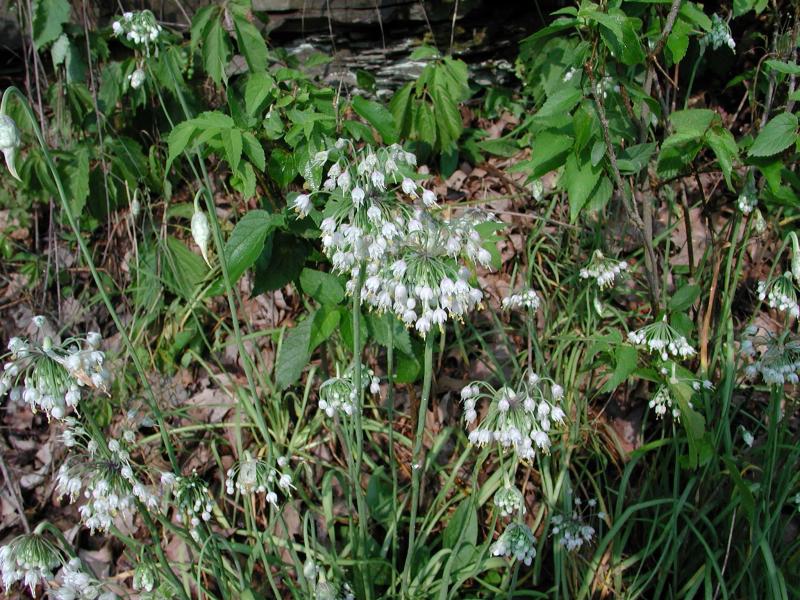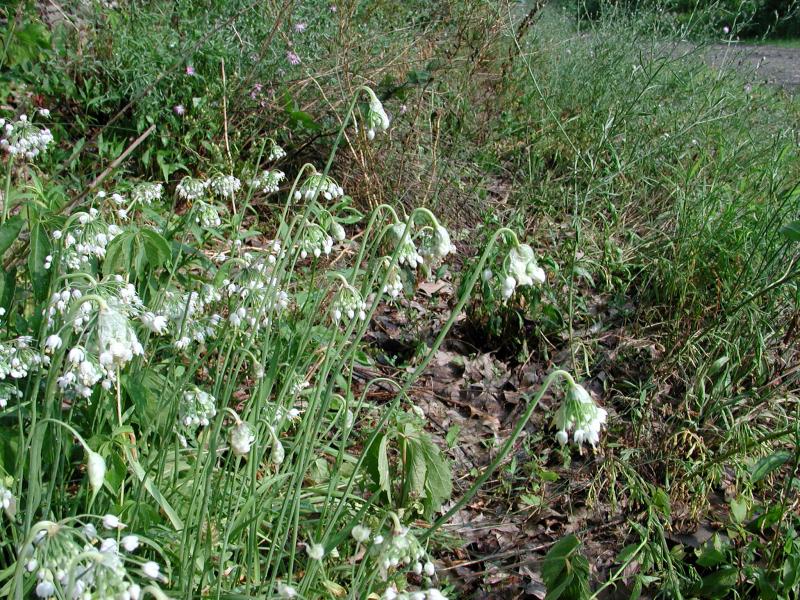Nodding Wild Onion
Allium cernuum var. cernuum None
- Class
- Monocotyledoneae (Monocots)
- Family
- Amaryllidaceae
- State Protection
- Threatened
Listed as Threatened by New York State: likely to become Endangered in the foreseeable future. For animals, taking, importation, transportation, or possession is prohibited, except under license or permit. For plants, removal or damage without the consent of the landowner is prohibited.
- Federal Protection
- Not Listed
- State Conservation Status Rank
- S2
Imperiled in New York - Very vulnerable to disappearing from New York due to rarity or other factors; typically 6 to 20 populations or locations in New York, very few individuals, very restricted range, few remaining acres (or miles of stream), and/or steep declines.
- Global Conservation Status Rank
- G5T5
Secure globally - Both the species as a whole and the subspecies/variety are common in the world; widespread and abundant (but may be rare in some parts of its range).
Summary
Did you know?
Nodding wild onion was first collected in New York in 1831 on the banks of Seneca Lake by Asa Gray's friend Nathan Folwell, a botanist from the town of Romulus, on the shores of Seneca Lake. Plants still survive along the lake today.
State Ranking Justification
There are seven existing populations and most of them have over 100 plants each. There are 22 additional historical occurrences colleted from the 1880s to the 1950s.
Short-term Trends
The short-term trend is stable.
Long-term Trends
There seems to have been a moderate decline in populations from the past but many historical records have not been searched in detail so the species may be more common than we think.
Conservation and Management
Threats
Some populations occur along roadsides and are subject to road salt and future road improvements. There has been some herbicide use close to plants that are near a right-of-way. Some plants near a waterfall are subject to trampling.
Conservation Strategies and Management Practices
Roadside management should avoid nearby populations.
Research Needs
There are no research needs at this time.
Habitat
Habitat
In contrast to its habitat elsewhere in its range, in New York nodding wild onion has been collected most often from dry, rocky (often shaly) sites, such as cliffs and talus slopes. It occurs on open sites such as powerlines and mowed roadsides, as well as woodlands and oak-hickory forests (New York Natural Heritage Program 2013). Widely distributed on moist soils in mountainous and cool regions (FNA 2002). Marshy ground, swales and meadows, grassy forested banks, spreading along railroad embankments and roadsides (Reznicek et al 2013). Dry woods, rocky banks, and prairies (Gleason and Cronquist 1991).
Associated Ecological Communities
- Appalachian oak-hickory forest
(guide)
A hardwood forest that occurs on well-drained sites, usually on ridgetops, upper slopes, or south- and west-facing slopes. The soils are usually loams or sandy loams. This is a broadly defined forest community with several regional and edaphic variants. The dominant trees include red oak, white oak, and/or black oak. Mixed with the oaks, usually at lower densities, are pignut, shagbark, and/or sweet pignut hickory.
- Calcareous cliff community
(guide)
A community that occurs on vertical exposures of resistant, calcareous bedrock (such as limestone or dolomite) or consolidated material; these cliffs often include ledges and small areas of talus.
- Mowed roadside/pathway
A narrow strip of mowed vegetation along the side of a road, or a mowed pathway through taller vegetation (e.g., meadows, old fields, woodlands, forests), or along utility right-of-way corridors (e.g., power lines, telephone lines, gas pipelines). The vegetation in these mowed strips and paths may be dominated by grasses, sedges, and rushes; or it may be dominated by forbs, vines, and low shrubs that can tolerate infrequent mowing.
- Shale cliff and talus community
(guide)
A community that occurs on nearly vertical exposures of shale bedrock and includes ledges and small areas of talus. Talus areas are composed of small fragments that are unstable and steeply sloping; the unstable nature of the shale results in uneven slopes and many rock crevices.
- Successional old field*
A meadow dominated by forbs and grasses that occurs on sites that have been cleared and plowed (for farming or development), and then abandoned or only occasionally mowed.
- Successional shrubland*
A shrubland that occurs on sites that have been cleared (for farming, logging, development, etc.) or otherwise disturbed. This community has at least 50% cover of shrubs.
* probable association but not confirmed.
Associated Species
- Acer rubrum
- Ailanthus altissima (tree-of-heaven)
- Antennaria plantaginifolia (plantain-leaved pussy-toes)
- Apocynum cannabinum (Indian-hemp)
- Aquilegia canadensis (wild columbine, red columbine)
- Betula nigra (river birch)
- Campanula rotundifolia (hare-bell)
- Carya glabra (pignut hickory)
- Celtis occidentalis (northern hackberry)
- Dryopteris marginalis (marginal wood fern)
- Fraxinus americana (white ash)
- Pinus rigida (pitch pine)
- Populus deltoides
- Quercus alba (white oak)
- Quercus coccinea (scarlet oak)
- Quercus rubra (northern red oak)
- Rhamnus cathartica (European buckthorn)
- Tsuga canadensis (eastern hemlock)
Range
New York State Distribution
Nodding Wild Onion is known mostly from the central southern tier of counties, from Allegheny in the west to Tioga in the east. There are also historical collections from Erie, New York, and Rennsalaer Counties.
Global Distribution
This onion ranges from Nova Scotia to North Dakota in the north, south as far as North Carolina and Tennessee in the Appalachians, and west to Missouri.
Identification Comments
Identifying Characteristics
Nodding wild onion is grass-like perennial which grows up to 60 cm tall from short-rhizomatous bulbs. The leaves are flat and 2-8 mm wide.The inflorescence is a nodding, rounded cluster of bell-shaped flowers (umbel) borne on leaf-less flower stalk (scape) with a bent or reflexed tip. The flowers are normally white but also may be pink to rose in color.
Best Life Stage for Proper Identification
For positive identification nodding wild onion should ideally be in flower or fruit. With flowers or fruits, only the upper portion of the stem is needed. Positive identification in vegetative condition requires the entire plant, including leaves and bulbs -- but please do not collect this rare native onion species.
Similar Species
When compared to other Allium species native to New York, Allium cernuum var. cernuum is unique due to its basal leaves and nodding flowers. Allium vineale, an introduced and weedy species which may sometimes invade similar habitat, has erect rather than nodding infloresences and has generally taller leaves that are hollow at the base (to 60 cm versus 10 to 25 cm for A. cernuum).
Best Time to See
Allium cernuum var. cernuum flowers from mid-June through August.
- Vegetative
- Flowering
- Fruiting
The time of year you would expect to find Nodding Wild Onion vegetative, flowering, and fruiting in New York.
Nodding Wild Onion Images
Taxonomy
Nodding Wild Onion
Allium cernuum var. cernuum None
- Kingdom Plantae
- Phylum Anthophyta
- Class Monocotyledoneae
(Monocots)
- Order Asparagales
- Family Amaryllidaceae
- Order Asparagales
- Class Monocotyledoneae
(Monocots)
- Phylum Anthophyta
Additional Common Names
- Wild Onion
Comments on the Classification
All of our Allium cernuum are variety cernuum.
Additional Resources
Best Identification Reference
McNeal D. W. and T. D. Jacobsen. Allium L. Pages 224-276 in Flora of North America Editorial Committee. 2002a. Flora of North America North of Mexico. Vol. 26. Magnoliophyta: Liliidae: Liliales and Orchidales. Oxford Univ. Press, New York. xxvi + 723 pp.
Other References
Gleason, Henry A. and A. Cronquist. 1991. Manual of Vascular Plants of Northeastern United States and Adjacent Canada. The New York Botanical Garden, Bronx, New York. 910 pp.
Holmgren, Noel. 1998. The Illustrated Companion to Gleason and Cronquist's Manual. Illustrations of the Vascular Plants of Northeastern United States and Adjacent Canada. The New York Botanical Garden, Bronx, New York.
New York Natural Heritage Program. 2024. New York Natural Heritage Program Databases. Albany, NY.
Reznicek, A.A., E. G. Voss, & B. S. Walters. February 2011. University of Michigan. Web. 2-18-2013. http://www.michiganflora.net/home.aspx.
Weldy, T. and D. Werier. 2010. New York flora atlas. [S.M. Landry, K.N. Campbell, and L.D. Mabe (original application development), Florida Center for Community Design and Research http://www.fccdr.usf.edu/. University of South Florida http://www.usf.edu/]. New York Flora Association http://newyork.plantatlas.usf.edu/, Albany, New York
Links
About This Guide
This guide was authored by: Stephen M. Young
Information for this guide was last updated on: April 2, 2013
Please cite this page as:
New York Natural Heritage Program. 2024.
Online Conservation Guide for
Allium cernuum var. cernuum.
Available from: https://guides.nynhp.org/nodding-wild-onion/.
Accessed July 26, 2024.


